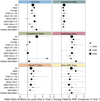Hospital crossover increases utilization for people with epilepsy: a retrospective cohort study
- PMID: 25571986
- PMCID: PMC4610742
- DOI: 10.1111/epi.12882
Hospital crossover increases utilization for people with epilepsy: a retrospective cohort study
Abstract
Objectives: "Hospital crossover" occurs when people visit multiple hospitals for care, which may cause gaps in electronic health records. Although crossover is common among people with epilepsy, the effect on subsequent use of health services is unknown. Understanding this effect will help prioritize health care delivery innovations targeted for this population.
Methods: We collected de-identified information from a health information exchange network describing 7,836 people with epilepsy who visited any of seven hospitals in New York, NY from 2009-2012. Data included demographics, comorbidities, and 2 years of visit information from ambulatory, inpatient, emergency department (ED), and radiology settings. We performed two complementary retrospective cohort analyses, in order to (1) illustrate the effect on a carefully selected subgroup, and (2) confirm the effect across the study population. First, we performed a matched cohort analysis on 410 pairs of individuals with and without hospital crossover in the baseline year. Second, we performed a propensity score odds weighted ordinal logistic regression analysis to estimate the effect across all 7,836 individuals. The outcomes were the use of six health services in the follow-up year.
Results: In the matched pair analysis, baseline hospital crossover increased the odds of more visits in the ED (odds ratio 1.42, 95% confidence interval [CI] 1.05-1.95) and radiology settings (1.7, 1.22-2.38). The regression analysis confirmed the ED and radiology findings, and also suggested that crossover led to more inpatient admissions (1.35, 1.11-1.63), head CTs (1.44, 1.04-2), and brain MRIs (2.32, 1.59-3.37).
Significance: Baseline hospital crossover is an independent marker for subsequent increased health service use in multiple settings among people with epilepsy. Health care delivery innovations targeted for people with epilepsy who engage in hospital crossover should prioritize (1) sharing radiology images and reports (to reduce unnecessary radiology use, particularly head CTs), and (2) improving coordination of care (to reduce unnecessary ED and inpatient use).
Keywords: Care coordination; Epilepsy; Health information exchange; Health information technology; Health services research.
Wiley Periodicals, Inc. © 2015 International League Against Epilepsy.
Conflict of interest statement
Dr. Shapiro was a paid consultant for Healthix Inc., from 2011 to 2012. The remaining authors have no conflicts of interest. The funding sources had no role in any of the following: design and conduct of the study; collection, management, analysis, and interpretation of the data; and preparation, review, or approval of the manuscript; furthermore, funding sources had no role in the decision to submit the manuscript for publication. We confirm that we have read the Journal’s position on issues involved in ethical publication and affirm that this report is consistent with those guidelines.
Figures




References
-
- Smith PC, Araya-Guerra R, Bublitz C, et al. Missing clinical information during primary care visits. Jama. 2005 Feb 2;293:565–571. - PubMed
Publication types
MeSH terms
Grants and funding
LinkOut - more resources
Full Text Sources
Other Literature Sources
Medical
Molecular Biology Databases
Research Materials

